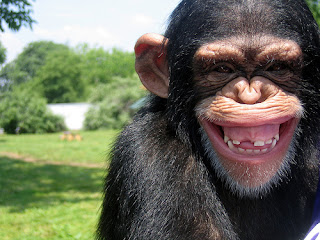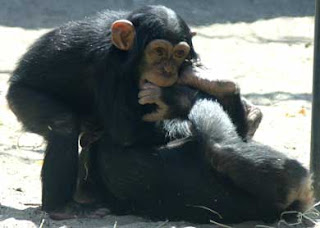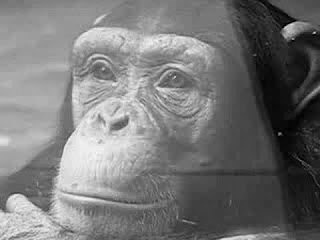Los chimpancés son unos simios que viven en las junglas y praderas africanas, y son animales muy inteligentes: se despiojan unos a otros, se toman de la mano, se besan e incluso pueden sonreír.
Son capaces de fabricar herramientas, como ramas de los árboles para comer insectos, y utilizarlas, como palitos o piedras para obtener deliciosos manjares, a diferencia de otros monos y simios.
Pasan horas limpiándose unos a otros, sus manos son útiles para quitar pequeñas semillas, suciedad y piojos. Utilizan las hojas de los árboles como esponjas cuando se bañan.
Por todas estas cosas, son muchos los que encuentran a los chimpancés parecidos pero diferentes a los hombres. Se cree que los linajes humano y chimpancé se dividieron hace aproximadamente siete millones de años.
En ese tiempo, muchas especies de homínidos aparecían y desaparecían, hasta que finalmente evolucionaron en el Homo sapiens.
Nuestra especie posee una serie de características que los chimpancés no tienen: caras aplanadas, cerebros más grandes, espinas dorsales rectas y manos y pies altamente especializados.
Los chimpancés son nuestros parientes vivos más cercanos; comparten aproximadamente el 96% de nuestro ADN.
Un ejemplar macho adulto puede alcanzar 1,60 m de estatura. Por lo general, tienen el cuerpo recubierto de pelo liso, de un color negro lustroso, que en algunos ejemplares presenta reflejos castaños rojizos mate.
Se mantienen en grupos que ocupan territorios de entre 10 0 20 kilómetros cuadrados. Los machos establecen alianzas políticas para tener el poder dentro del grupo.
Viajan y comen sobre el suelo; pero duermen en los árboles, donde construyen sus nidos a no demasiada altura, entrecruzando ramajes y ramitas que apoyan sobre una rama sólida en forma de horquilla.
Normalmente andan sobre sus cuatro patas. Aunque a menudo, a aquellos que habitan en la sabana se los ve caminando sobre sus dos patas traseras y haciendo uso de ramas u otros objetos para ayudarse, como si fueran bastones.
Son omnívoros: se alimentan de frutas, brotes vegetales y hojas; también comen hormigas y termitas, huevos de ave y miel. En ocasiones, se alimentan de primates inferiores y pequeños mamíferos.
A sus crías les encanta jugar, pasan la mayor parte del tiempo haciéndolo, lo que les sirve para aprender a imitar a los adultos: buscan alimentos, usan herramientas o practican cómo trepar.
A pesar de ser nuestros parientes vivos más cercanos, estos animales se encuentran en peligro de extinción por responsabilidad del ser humano.
Ecologistas y conservacionistas han advertido que los grandes simios se hallan en riesgo: quedan solo 650 gorilas, apenas 25.000 orangutanes y cerca de 38.000 chimpancés en todo el mundo.
Sus mayores problemas son la reducción de su hábitat natural por la destrucción de los bosques, las guerras civiles, la caza furtiva, venta de su carne y comercio de simios vivos.
Chimpanzees are apes living in the jungles and African grasslands, and are very intelligent animals: they despiojan each other, they hold hands, kiss and even can smile.
They are able to make tools such as tree branches to eat insects, and use them as sticks or rocks to get delicious food, unlike other monkeys and apes.
They spend hours wiping each other, their hands are useful for removing small seeds, dirt and lice. The leaves of the trees like sponges when they bathe.
For all these things, there are many who are similar to chimpanzees but different from men. It is believed that the human and chimpanzee lineages split about seven million years.
At that time, many species of hominids appeared and disappeared, until finally evolved into Homo sapiens.
Our species has a number of features that chimpanzees do not have: flattened faces, larger brains, spines straight and highly specialized hands and feet.
Chimpanzees are our closest living relatives, sharing approximately 96% of our DNA.
An adult male specimen can reach 1.60 m in height. Usually, their bodies covered with hair smooth, shiny black color, in some specimens have auburn highlights mate.
They stay in groups occupying territories between 10 0 20 square kilometers. Males establish political alliances to have the power within the group.
They travel and eat on the ground, but roost in trees, where they build their nests not too high, crisscrossing branches and twigs on a branch supporting forked solid.
Normally walk on all fours. Although often, those who live in the savanna are seen walking on their hind legs and using branches or other objects to help, like canes.
They are omnivores: they feed on fruits, vegetables and sprouts leaves, also eat ants and termites, bird eggs and honey. Occasionally feed on small mammals and lower primates.
Their young love to play, spend most time doing, which helps them to learn to imitate adults: look for food, use tools or practice how to climb.
Despite being our closest living relatives, these animals are endangered by human responsibility.
Ecologists and conservationists have warned that the great apes are at risk: are only 650 gorillas, orangutans just 25,000 and about 38,000 chimpanzees worldwide.
Their biggest problems are reducing their natural habitat by forest destruction, civil wars, poaching, selling their meat and live ape trade.







No hay comentarios:
Publicar un comentario